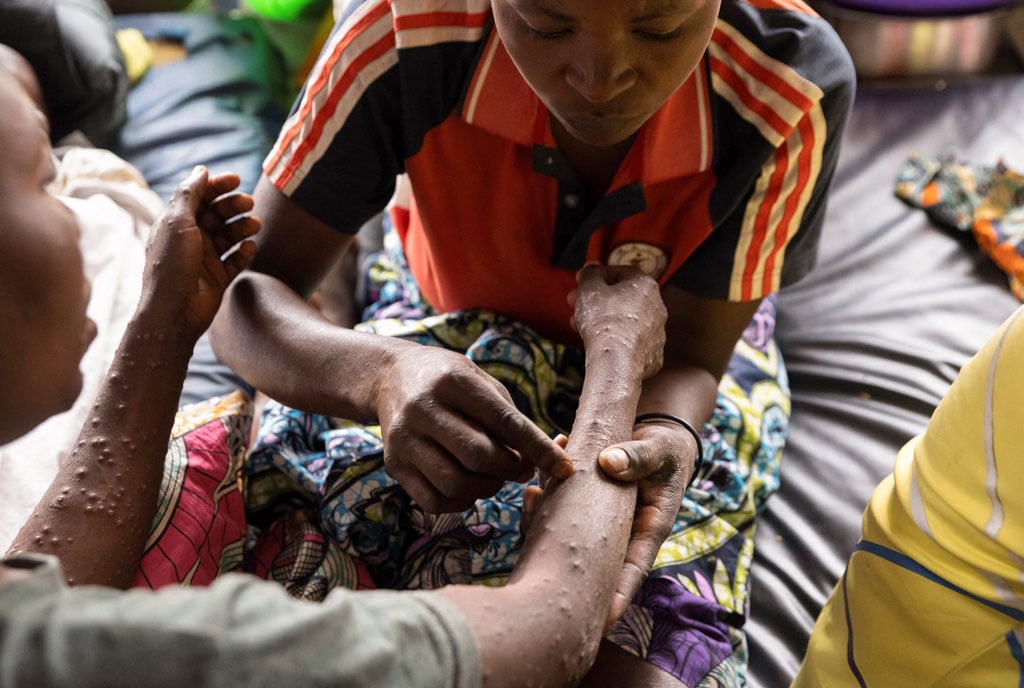Mpox cases double, Kampala metropolitan area hit hardest

Suspected Mpox patients wait at the Mpox isolation ward at the Kavumu hospital in Kabare territory, South Kivu province of the Democratic Republic of Congo, August 29, 2024. PHOTO/REUTERS
What you need to know:
Fifty percent of the cases were registered in the Kampala metropolitan Area (Kampala, Wakiso and Mukono)
The number of confirmed Mpox cases in the country has doubled in eight days, statistics from the Ministry of Health show.
As of September 17, the cumulative number of confirmed cases reached 22, up from 11 cases recorded by September 10, the Ministry reported in an update on Wednesday night.
Fifty percent of the cases were registered in the Kampala Metropolitan Area (Kampala, Wakiso and Mukon).
According to the ministry’s statistics, Kampala has the highest number of cases (six), followed by Kasese and Wakiso (each has four cases), and Mayuge (three). Amuru, Nakaseke, Nakasongola, Kagadi, and Mukono districts each have one case.
Scientists blamed the high number of cases in the Kampala Metropolitan Area on crowding.
“The cumulative total confirmed Mpox cases since the declaration of the outbreak are 22. No death has been registered among the confirmed cases. Case Fatality Ratio (CFR) is at 00/22 (0 percent),” the document from the ministry reads in part.
The lack of deaths reported in Uganda may indicate that the patients are being managed well.
Information from the Africa CDC on September 13, indicates that “since the beginning of this year, as of the end of week 35 (September 1), a total of 26,544 cases of which 5,732 were confirmed and 724 deaths have been reported from 15 African Union (AU) Member States.”
The ministry also indicated that seven people have so far recovered while two are still admitted in hospital, leaving questions about the whereabouts of 13 cases.
“There are different levels of recoveries. Others are in isolation and others are out but they are still being monitored,” Lt Col Dr Henry Kyobe, the Mpox incident commander, said in an interview yesterday.
Dr Kyobe said they don’t have evidence that there is community spread of the viral disease which was first reported in the country in July.
Mr Emmanuel Ainebyoona, the spokesperson of the ministry, said they have the situation under control, re-echoing the remarks by Health minister Jane Ruth Aceng last week.
“The numbers are negligible. They shouldn’t create room to worry,” he said.
Dr Jane Ruth Aceng, the Health minister, said they are using past experiences in managing other outbreaks to tame the Mpox spread.
She said the same methods used to prevent the spread of Covid-19 are applicable in taming Mpox. She appealed to Ugandans to avoid physical contact, wash hands regularly with soap and water, avoid sharing clothes and bedding, and also avoid sexual intercourse with people they do not know.
ABOUT MPOX
The viral disease spreads through close physical contact, sexual intercourse, and sharing clothes or materials touched by an infected person. The disease starts manifesting with fever, and body weakness followed by skin rash, blisters, and pus-filled sores on the skin.
According to information from the Health Ministry, if one develops symptoms, particularly someone who recently travelled overseas or had contact with a case, including sexual contact, they should seek care from a general health practitioner or the nearest sexual health clinic. “People who have had Mpox or symptoms consistent with Mpox should not be stigmatised but handled with compassion and care. Much as the disease is contagious, but it is curable,” the Ministry advised.




